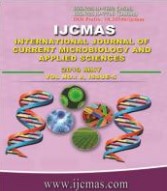


 National Academy of Agricultural Sciences (NAAS)
National Academy of Agricultural Sciences (NAAS)

|
PRINT ISSN : 2319-7692
Online ISSN : 2319-7706 Issues : 12 per year Publisher : Excellent Publishers Email : editorijcmas@gmail.com / submit@ijcmas.com Editor-in-chief: Dr.M.Prakash Index Copernicus ICV 2018: 95.39 NAAS RATING 2020: 5.38 |
A field experiment was conducted on clayey soil during Rabi season of 2011-12 to 2013-2014 to study effects of foliar application of organic and inorganic substances on the yield of chick pea (GJG-3) under limited water supply at Main Dry Farming Research Station, Junagadh Agricultural University, Targhadia. The experiment comprising of 2 main plot (2 levels of irrigation) and seven sub plot treatments (spraying of organic and inorganic substances) laid out in split plot design with three replications. Effect of foliar application of organic and inorganic substances treatments on root length, plant height, number of branches/plant, and mature pods/plant at 75 DAS and maturity were significantly improved under two irrigation (one irrigation at flowering and second at pod development stage (I2). The stem growth rate, leaf growth rate, pod growth rate and crop growth rate were significantly affected due to combined effect of irrigation and foliar sprays but root growth rate and partitioning percentage were non-significant. The significantly higher yields (pod, seed, straw, biological), shelling %, 100 pod weight, and 100 seed weight of gram were obtained due to foliar spraying of T1 (KNO3 @ 2%), T2 (Urea @ 2%) and T5 (Cow urine 100 ml/l) as compared to control. While, yields (pod, seed, straw and biological), harvest index, shelling %, 100 pod weight, 100 seed weight of gram were not significantly affected due to combined effect of irrigation and foliar spray during all the years of experimentation as well as in pooled results. While seed index was significantly affected due to foliar spray in the year 2012. On the basis of pooled result the data indicated that two irrigation (one irrigation at flowering and second at pod development stage I2) gave the highest gross income (Rs.57904/ha) and net return (Rs.39213/ha). Foliar application with KNO3 @ 2% at flowering and pod development stages found better in respect of gross income (Rs.59285/ha), net return (Rs.39634/ha) and B:C ratio 3.02.
 |
 |
 |
 |
 |